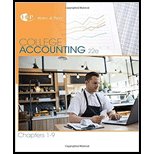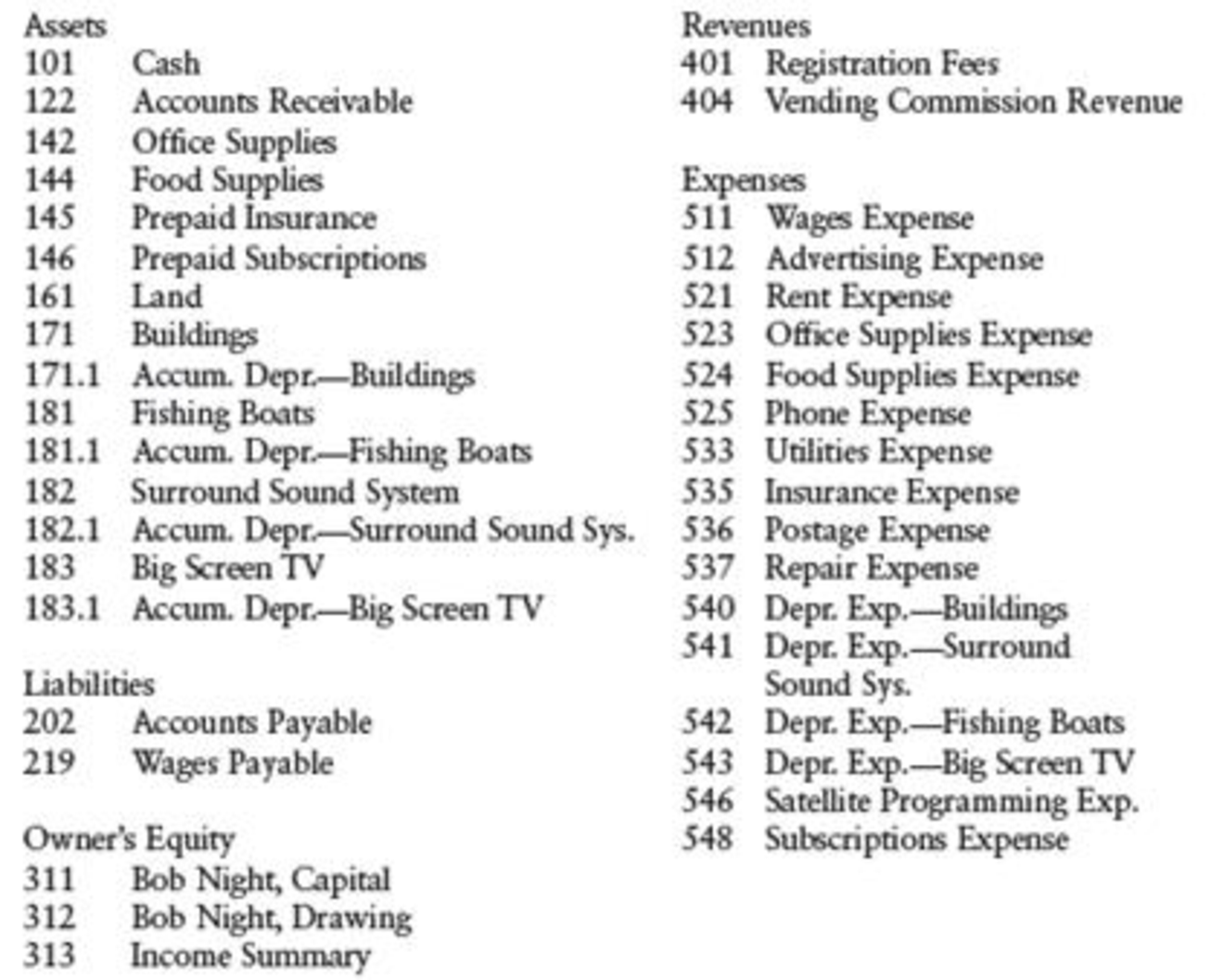
Concept explainers
Comprehensive Problem 1, Period 2: The Accounting Cycle
During the month of May 20--, The General’s Favorite Fishing Hole engaged in the following transactions. These transactions required an expansion of the chart of accounts as shown below.

May 1 In order to provide snacks for guests on a 24-hour basis, Night signed a contract with Snack Attack. Snack Attack will install vending machines with food and drinks and pay a 10% commission on all sales. Estimated payments are made at the beginning of each month. Night received a check for $200, the estimated commission on sales for May.
2 Night purchased a surround sound system and big screen TV with a digital satellite system for the guest lounge. The surround sound system cost $3,600 and has an estimated useful life of five years and no salvage value. The TV cost $8,000, has an estimated useful life of eight years, and has a salvage value of $800. Night paid cash for both items.
2 Paid for May’s programming on the new digital satellite system, $125.
3 Night’s office manager returned $100 worth of office supplies to Gordon Office Supply. Night received a $100 reduction on the account.
3 Deposited registration fees, $52,700.
May 3 Paid rent for lodge and campgrounds for the month of May, $40,000.
3 In preparation for the purchase of a nearby campground, Night invested an additional $600,000.
4 Paid Gordon Office Supply on account, $400.
4 Purchased the assets of a competing business and paid cash for the following: land, $100,000; lodge, $530,000; and fishing boats, $9,000. The lodge has a remaining useful life of 50 years and a $50,000 salvage value. The boats have remaining lives of five years and no salvage value.
5 Paid May’s insurance premium for the new camp, $1,000. (See above transaction.)
5 Purchased food supplies from Acme Super Market on account, $22,950.
5 Purchased office supplies from Gordon Office Supplies on account, $1,200.
7 Night paid $40 each for one-year subscriptions to Fishing Illustrated, Fishing Unlimited, and Fish Master. The magazines are published monthly.
10 Deposited registration fees, $62,750.
13 Paid wages to fishing guides, $30,000. (Don’t forget wages payable.)
14 A guest became ill and was unable to stay for the entire week. A refund was issued in the amount of $1,000.
17 Deposited registration fees, $63,000.
19 Purchased food supplies from Acme Super Market on account, $18,400.
21 Deposited registration fees, $63,400.
23 Paid $2,500 for advertising spots on National Sports Talk Radio.
25 Paid repair fee for damaged boat, $850.
27 Paid wages to fishing guides, $30,000.
28 Paid $1,800 for advertising spots on billboards.
29 Purchased food supplies from Acme Super Market on account, $14,325.
30 Paid utilities bill, $3,300.
30 Paid phone bill, $1,800.
30 Paid Acme Super Market on account, $47,350.
31 Bob Night withdrew cash for personal use, $7,500.
Adjustment information at the end of May is provided below.
- (a) Total vending machine sales were $2,300 for the month of May. A 10% commission is earned on these sales.
- (b) Straight-line
depreciation is used for the 10 boats purchased on April 2 for $60,000. The useful life for these assets is five years and there is no salvage value. A full month’s depreciation was taken in April on these boats. Straight-line depreciation is also used for the two boats purchased in May. Make one adjusting entry for all depreciation on the boats. - (c) Straight-line depreciation is used to depreciate the surround sound system.
- (d) Straight-line depreciation is used to depreciate the big screen TV.
- (e) Straight-line depreciation is used for the building purchased in May.
- (f) On April 2, Night paid $9,000 for insurance during the six-month camping season. May’s portion of this premium was used up during this month.
- (g) Night received his May issues of Fishing Illustrated, Fishing Unlimited, and Fish Master.
- (h) Office supplies remaining on hand, $150.
- (i) Food supplies remaining on hand, $5,925.
- (j) Wages earned, but not yet paid at the end of May, $6,000.
REQUIRED
- 1. Enter the transactions in a general journal. Enter transactions from May 1–4 on page 5, May 5–28 on page 6, and the remaining entries on page 7. To save time and space, don’t enter descriptions for the
journal entries. - 2. Post the entries to the general ledger. (If you are not using the working papers that accompany this text, you will need to enter the account titles, account numbers, and balances from April 30 in the general ledger accounts.)
- 3. Prepare a
trial balance on a work sheet. - 4. Complete the work sheet.
- 5. Journalize the
adjusting entries on page 8 of the general journal. - 6. Post the adjusting entries to the general ledger.
- 7. Prepare the income statement.
- 8. Prepare the statement of owner’s equity.
- 9. Prepare the
balance sheet . - 10. Journalize the closing entries on page 9 of the general journal.
- 11. Post the closing entries to the general ledger.
- 12. Prepare a post-closing trial balance.
Trending nowThis is a popular solution!

Chapter 6A Solutions
Bundle: College Accounting, Chapters 1-9, Loose-Leaf Version, 22nd + LMS Integrated for CengageNOWv2, 2 terms Printed Access Card for Heintz/Parry's College Accounting, Chapters 1-27, 22nd
- Patterson Brothers recently reported an EBITDA of $8.8 million and a net income of $2.4 million. It had $2 million in interest expense, and its corporate tax rate was 45%. What was its charge for depreciation and amortization? Answer this questionarrow_forwardA firm has a profit margin of 19 percent on sales of $24,000,000. If the firm has total assets of $23,500,000, and an after-tax interest cost on total debt of 5 percent, what is the firm's ROA? a. 12.9% b. 19.4% c. 12.0% d. 13.3% e. 15.1%arrow_forwardHow many units must company sell?arrow_forward
- What is the effect of using standard costs? A. Can make management planning more difficult. B. Promotes greater economy. C. Does not help in setting prices. D. Weakens management control.arrow_forwardPatterson Brothers recently reported an EBITDA of $8.8 million and a net income of $2.4 million. It had $2 million in interest expense, and its corporate tax rate was 45%. What was its charge for depreciation and amortization?arrow_forwardWhat was it's charges for depression and amortizationarrow_forward
- What is the company's unit contribution margin?arrow_forwardWhat is the actual cost per yard of fabric purchased? Dazzle Fabrics manufactures a specialty monogrammed blanket. The following are the cost standards for this blanket: Data Table Direct materials (fabric) 2.0 yards per blanket at $7.00 per yard Direct labor 0.5 direct labor hours per blanket at $19.00 per hour Actual results from last month's production of 2,400 blankets are as follows: Data Table Actual cost of 6,240 yards of direct material (fabric) Actual yards of direct material (fabric) used Actual wages for 1,350 direct labor hours worked $ 40,560 5,540 $ 24,840arrow_forwardprovide final solution in this general account queryarrow_forward
 Financial Accounting: The Impact on Decision Make...AccountingISBN:9781305654174Author:Gary A. Porter, Curtis L. NortonPublisher:Cengage LearningPrinciples of Accounting Volume 1AccountingISBN:9781947172685Author:OpenStaxPublisher:OpenStax College
Financial Accounting: The Impact on Decision Make...AccountingISBN:9781305654174Author:Gary A. Porter, Curtis L. NortonPublisher:Cengage LearningPrinciples of Accounting Volume 1AccountingISBN:9781947172685Author:OpenStaxPublisher:OpenStax College Managerial AccountingAccountingISBN:9781337912020Author:Carl Warren, Ph.d. Cma William B. TaylerPublisher:South-Western College Pub
Managerial AccountingAccountingISBN:9781337912020Author:Carl Warren, Ph.d. Cma William B. TaylerPublisher:South-Western College Pub Excel Applications for Accounting PrinciplesAccountingISBN:9781111581565Author:Gaylord N. SmithPublisher:Cengage Learning
Excel Applications for Accounting PrinciplesAccountingISBN:9781111581565Author:Gaylord N. SmithPublisher:Cengage Learning College Accounting, Chapters 1-27AccountingISBN:9781337794756Author:HEINTZ, James A.Publisher:Cengage Learning,Century 21 Accounting Multicolumn JournalAccountingISBN:9781337679503Author:GilbertsonPublisher:Cengage
College Accounting, Chapters 1-27AccountingISBN:9781337794756Author:HEINTZ, James A.Publisher:Cengage Learning,Century 21 Accounting Multicolumn JournalAccountingISBN:9781337679503Author:GilbertsonPublisher:Cengage





